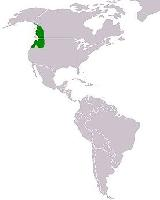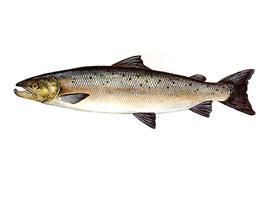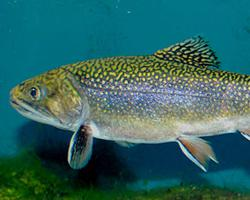
Greutăți și măsuri
| Lungime | de la 20 la 90 cm |
|---|
Starea de conservare
| Amenințat |
Descrierea animalului
The Rainbow Trout (Oncorhynchus mykiss) is a species of salmonid native to cold-water tributaries of the Pacific Ocean in Asia and North America. However, due to its popularity as a sport fish, it has been introduced worldwide. This species is known for its striking appearance and its ability to adapt to various aquatic environments, ranging from large lakes and rivers to small streams.Physically, the Rainbow Trout is a robust fish with a streamlined body that is built for strong currents and fast swimming. They typically measure between 20 to 30 inches in length and can weigh anywhere from 2 to 8 pounds, although specimens exceeding these dimensions have been recorded. The lifespan of a Rainbow Trout can vary widely depending on environmental conditions, with some living as long as 11 years.
One of the most distinctive features of the Rainbow Trout is its coloration. The fish's back is generally a dark shade of blue-green or olive, transitioning to a silvery white on the underside. The sides are adorned with a pinkish-red stripe that runs the length of the body, complemented by a sprinkling of small black spots that extend to the dorsal and caudal fins. This vibrant coloration is especially pronounced in males during the spawning season, making them a highly sought-after prize among anglers.
The Rainbow Trout's diet is as diverse as its habitat. Juveniles primarily feed on small invertebrates such as insects and crustaceans, while adults have a more varied diet that can include insects, smaller fish, fish eggs, and even small mammals or birds that fall into the water. This opportunistic feeding behavior supports their growth and the development of their muscular build, essential for enduring the fast-flowing streams in which they often reside.
Reproduction in Rainbow Trout is a fascinating process that typically occurs in spring or early summer. Females lay their eggs in shallow nests dug in the gravelly bottoms of streams, which are then fertilized by the males. These nests, known as redds, are fiercely protected by the females until the eggs hatch, after which the fry are left to fend for themselves. The survival rate of these young fish is low, but those that do make it to adulthood are known for their resilience and adaptability.
Rainbow Trout are not only celebrated by anglers for their fighting spirit and beauty but also hold significant ecological value. They are a key species in their native environments, contributing to the balance of aquatic ecosystems. Moreover, their presence in a body of water often indicates good water quality, as they require clean, oxygen-rich environments to thrive.
In conclusion, the Rainbow Trout is a remarkable fish that captivates with its stunning appearance and fascinating life cycle. Its adaptability and resilience have allowed it to thrive in diverse environments around the world, making it a beloved species among fishermen and conservationists alike. Whether leaping from a pristine stream or swimming in the depths of a cool lake, the Rainbow Trout remains one of the most iconic and cherished freshwater fish species.
Harta răspândirii

Animale similare
Fotografii noi cu animale
Top 10 animale
- Dolphin gull (Leucophaeus scoresbii)
- Diana monkey (Cercopithecus diana)
- Moustached guenon (Cercopithecus cephus)
- Galápagos tortoise (Geochelone nigra complex)
- Japanese macaque (Macaca fuscata)
- Russian tortoise (Testudo horsfieldii)
- Stone loach (Barbatula barbatula)
- Greek tortoise (Testudo graeca)
- Common flying dragon (Draco volans)
- Vendace (Coregonus albula)


